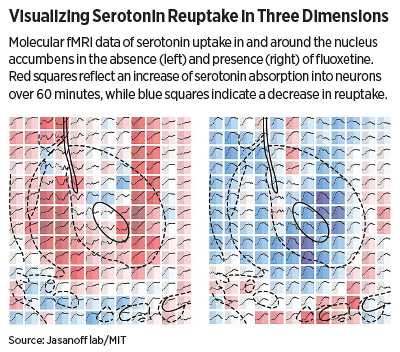A group of researchers at the Massachusetts Institute of Technology has developed an innovative technique for mapping serotonin transport in living animals. This approach, which uses functional magnetic resonance imaging (fMRI) to visualize serotonin reuptake in the brain, may one day aid the development and/or testing of novel antidepressants.
Although methods to track neurotransmitter dynamics in living brains currently exist, these methods have significant limitations. Electrochemical approaches can reveal fine details about serotonin transport, for example, but only in discrete points in the brain. Radioactive tracers provide a more global view of serotonin movement, but do not address the critical question of whether the serotonin is inside or outside of neurons.
“[T]he molecular fMRI paradigm … provides a unique capability for spatial and temporal analysis of drug action on neurochemical processes in the brain and could aid importantly in the characterization or selection of substances destined for clinical use,” Alan Jasanoff, Ph.D., a professor of biological engineering, and colleagues wrote in an article appearing in Neuron on October 19
In the piece, Jasanoff and colleagues described their method of attaching a chemical sensor called 2G9C6 to serotonin molecules that they later injected into the brains of rats. As soon as serotonin binds to a reuptake transporter, 2G9C6 detaches and starts emitting a signal that can be detected by fMRI.
To test the technique, the researchers administered either the selective serotonin reuptake inhibitor (SSRI) fluoxetine or an experimental dopamine reuptake inhibitor called GBR to rats. After 90 minutes, they microinjected sensor-bound serotonin near the animals’ striatum before placing the animals in an fMRI. The striatum is a major target of SSRIs and is associated with many behaviors including motivation, reward, and movement.
The researchers found that compared with rats given no drugs, the intensity of visible 2G9C6 increased more slowly across most of the striatum in the presence of fluoxetine, reflective of decreased serotonin reuptake. While Jasanoff said this finding was to be expected (since it is well known that fluoxetine blocks serotonin reuptake), this was the first time these dynamics could be mapped in three dimensions across a brain region.
Analysis of the fMRI data collected from animals administered GBR revealed a similar decrease in serotonin reuptake. In this instance, though, the effects were limited to three subregions of the striatum: the nucleus accumbens, lateral globus pallidus, and caudate nucleus-putamen (the last of which is particularly rich in dopamine neurons and is severely affected in Parkinson’s disease).
According to the authors, this discovery suggests a possible reason why some people do not show complete recovery when given an antidepressant that only targets one neurotransmitter, as receptors for other neurotransmitters might be able to contribute to serotonin reuptake.
Jasanoff said he and his team plan to study other regions of the brain using this technique to gain further knowledge of serotonin dynamics. They also discussed the possibility of broadening the range of this fMRI-based approach so they could observe multiple brain regions in the same experiment. This could be done by carrying out multiple injections in parallel or finding non-invasive ways to get sensors across the blood-brain barrier.
This study was funded by the National Institute on Drug Abuse, the National Institute of Neurological Disorders and Stroke, the Edmond and Lily Safra Center for Brain Sciences at the Hebrew University of Jerusalem, and the European Molecular Biology Organization. ■
An abstract of “Molecular fMRI of Serotonin Transport” can be accessed
here.

